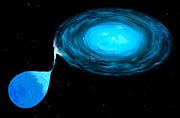- Number 303 |
- January 18, 2010
Scientists unite to solve mysteries of the plasma universe

Accretion occurs in a binary star
system when one star is paired
with a sufficiently compact star
such as a white dwarf, a neutron
star, or a black hole. Accretion
disks also form during star and
planet formation or at the center
of many active galaxies. How
accretion—or the matter
collection process—takes place
is one of the puzzles scientists
will discuss during the Workshop
on Opportunities in Plasma
Astrophysics at PPPL this week.
(Space Telescope Science Institute)
If a total solar eclipse is the most breathtaking spectacle that nature accords humans, then not far behind are the aurora borealis and, to the astronomers able to observe them, the eruption of a solar flare. For more than a century, scientists have known that the aurora and magnetism were inextricably linked. Today, no astronomer doubts that northern lights find their origins in violent events on the sun's surface, where during the eruption of a flare its magnetic field lines cross, reconnect and release the energy of up to a billion megaton bombs. And to a modern plasma physicist, this astronomical scenario is distressingly familiar—it is the same process that causes potentially dangerous disruptions in tokamaks, the mainline approach to fusion energy.
"Plasma physics governs much of the behavior of the visible universe at all scales, from tokamaks to extra-galactic jets that are ten billion times larger than the solar system," emphasizes Stewart Prager, Director of DOE's Princeton Plasma Physics Laboratory (PPPL). It is precisely this close relationship between tokamak physics and astrophysical phenomena that provides the motivation for the Workshop on Opportunities in Plasma Astrophysics (WOPA), to be held January 18-21 at PPPL. The workshop, Prager explains, will bring together several dozen experimentalists, astronomers and computational scientists from across the nation—and a few beyond the U.S.—to identify the major puzzles at this intersection of laboratory physics and space science, and to map out new strategies for better understanding the plasma universe.
Full story: http://www.pppl.gov/PPPLnews103.cfm
[Patti Wieser, 609-243-2757,
pwieser@pppl.gov]
